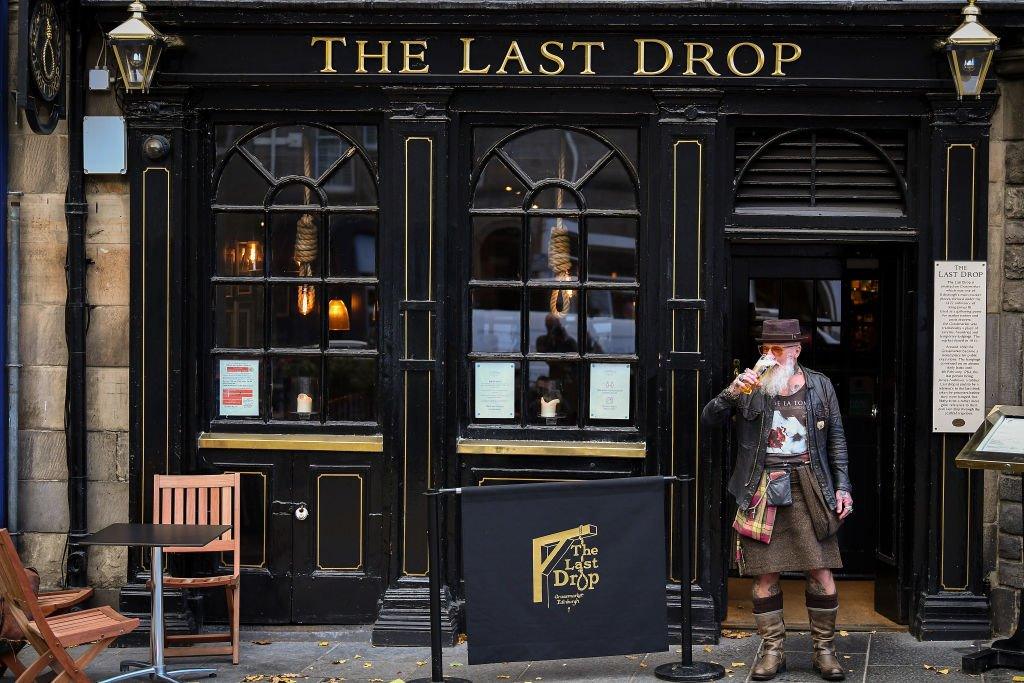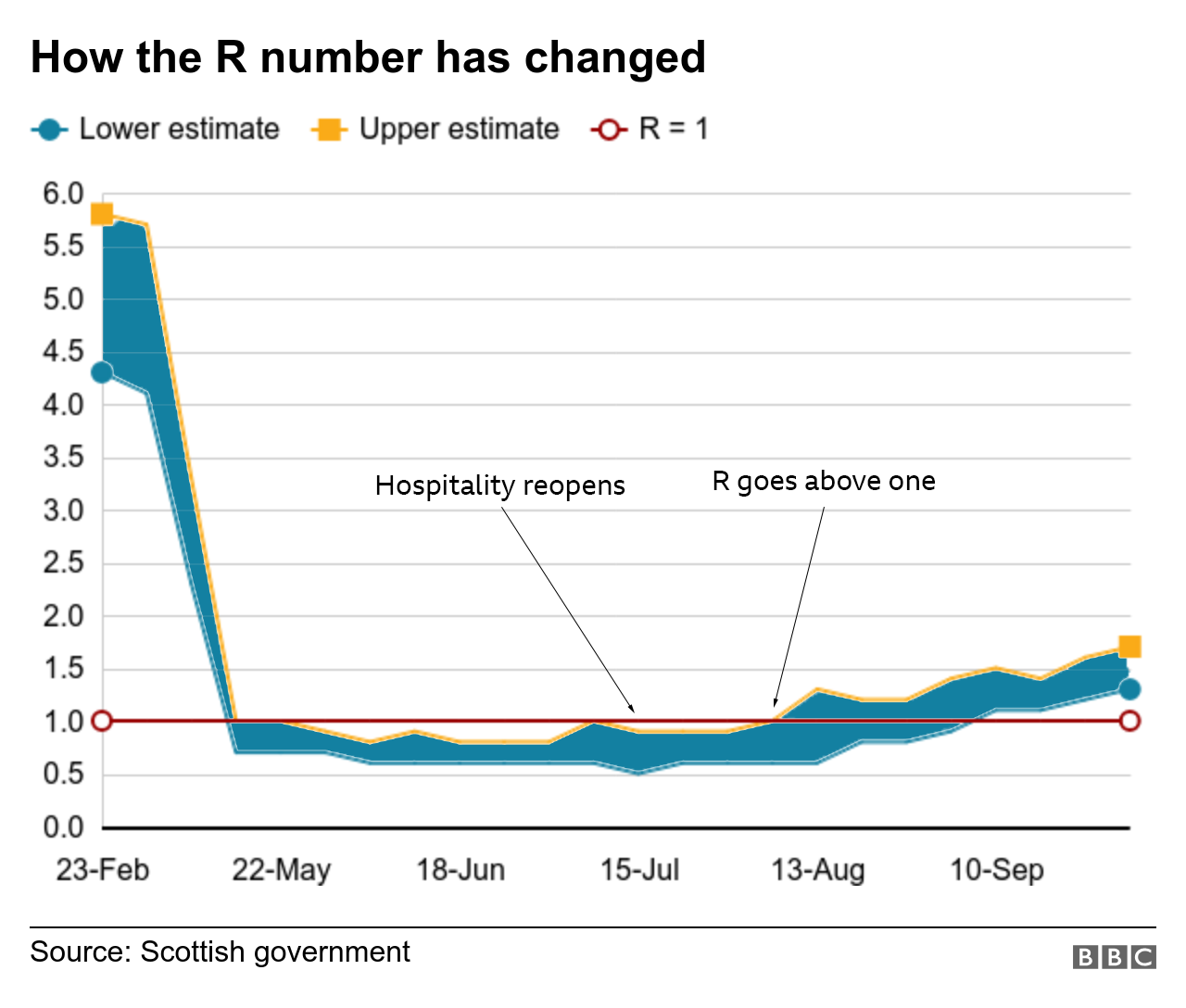Shutting Scotland's pubs - what's the evidence?
- Published

Pubs and restaurants across central Scotland are to be closed under the new measures
The Scottish government has published the evidence of its senior clinical advisers, external that guided strict new restrictions, especially on pubs and restaurants.
First Minister Nicola Sturgeon told the Scottish Parliament that the estimated total number of cases in Scotland is currently just 13% of the peak level back in March. But she warned that cases are rising quickly.
The evidence paper states that "at the current rate of growth (7% increase per day), the number of infections would be at the level of the March peak by the end of October".
Although the increase is across Scotland, certain areas across the central belt were giving particular concern.
The clinical advisers said: "Several health board areas including Greater Glasgow and Clyde, Lanarkshire and Lothian have been tracking rates in excess of 100 positive cases per 100,000 population over the past seven days."

NHS Ayrshire and Arran and NHS Forth Valley also have rates which are a concern and are included in the central belt restrictions.
The rate of 86 cases per 100,000 in NHS Western Isles represents 23 cases over the past week.
The evidence paper - from Chief Medical Officer Gregor Smith, Chief Nursing Officer Fiona McQueen and National Clinical Director Jason Leitch - said Scotland is continuing to closely track the situation in France with a four-week lag - and six weeks behind Spain.
Death rates in Spain increased significantly in mid-September and are now at a level 10 times the rate in Scotland.
Both France and Spain have introduced strict new measures to reduce their rising numbers of infections and deaths, including the closure of all bars in Paris for two weeks from 6 October.
The resurgence in these countries was initially concentrated among younger people but spread to other age groups.

Ms Sturgeon told the Scottish Parliament that the single most effective step to reduce transmission was taken 12 days ago when meeting in each other's home was stopped.
"That measure is vital, but the clinical advice I have received now is that it is not sufficient," she said.
In deciding what to do next there were some things she was not prepared to do.
"We are not closing schools, colleges or universities," she said. "We are not halting the remobilisation of the NHS for non-Covid care. And we are not asking people to stay at home."
Ms Sturgeon said she wanted a more "targeted approach" than the March lockdown.
This involves pubs, bars, restaurants and cafes closing in the central belt and operating under greatly reduced circumstances in the rest of the country, with no alcohol being served indoors.
What's the evidence for closing pubs?
The evidence paper says hospitality was closed during the lockdown and opened again on 15 July.
Modelling of the R value (reproduction number) at that time shows that about three weeks later it rose above 1, the level at which the virus begins to spread much more rapidly.

The clinical advisors said "this cannot be entirely attributed to hospitality" but it was likely to have played a significant role.
From the details of interviews that have been completed as part of Test and Protect, about 26% of individuals who have tested positive for Covid-19 since July have reported "exposure" to pubs, restaurants or cafes.
All ages are included but half of these people were 20-39.
The clinical advisers admitted that the data do not indicate where people who have tested positive were infected.
Unless there is a "clear and bounded outbreak" linked to a pub it is not usually possible to say exactly where someone picked up the virus.
"However it does highlight that people who have been infected have been in hospitality settings where they could have spread the virus to others," the paper says.
The evidence paper says that pubs and restaurant settings are difficult places to maintain physical distancing and other factors, such as poor ventilation and noise, make them places that could spread the virus.
"Generally this setting involves people of different ages with different individual risk profiles mixing with other households, or being seated in close proximity to other households, for more than 15 minutes," it says.
The paper also mentions the "disinhibiting impact of alcohol", which may make people less inclined to strictly follow the rules.
"For all of these reasons, significantly restricting licensed premises for 16 days temporarily removes one of the key opportunities the virus has to jump from household to household," Ms Sturgeon said.
"It is an essential part of our efforts to get the R number significantly below 1."

The choice of measures is a decision that the data cannot make for us.
The evidence shows that the current measures are not controlling the virus.
The number of people going into hospital with coronavirus is doubling roughly every fortnight and, if that pattern continues, the pressure would surely mount.
But the evidence cited by the first minister in support of the effectiveness of the measures announced today is not watertight.
She listed all of the reasons why indoor hospitality is a place where it is easy for the virus to spread and some data that support, but do not prove, that point.
The R value did rise above 1 about three weeks after pubs opened and just over 20% of people recently infected report having been to a pub, restaurant or café in the preceding week.
This doesn't prove that closing licensed venues after 6pm will turn the tide, or be more effective than doing so after 10pm.
But there is no single dataset or number that will map out a precise path through this epidemic.

